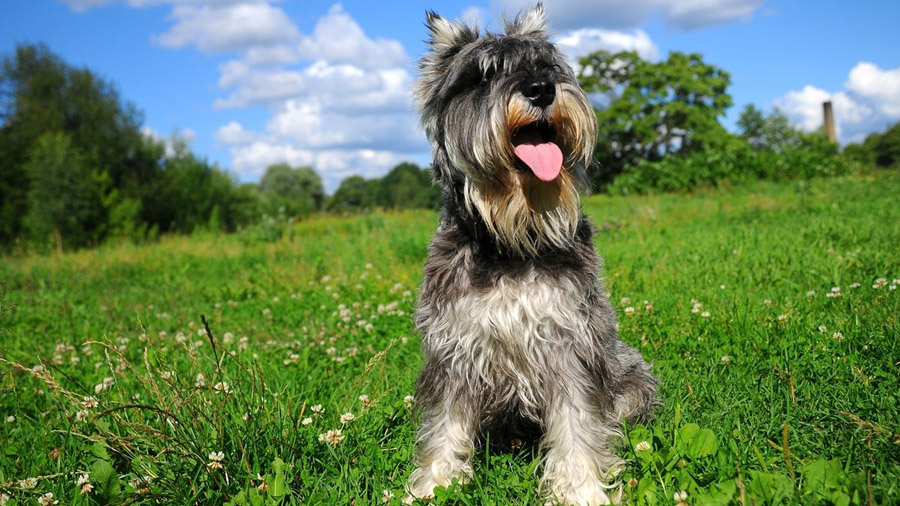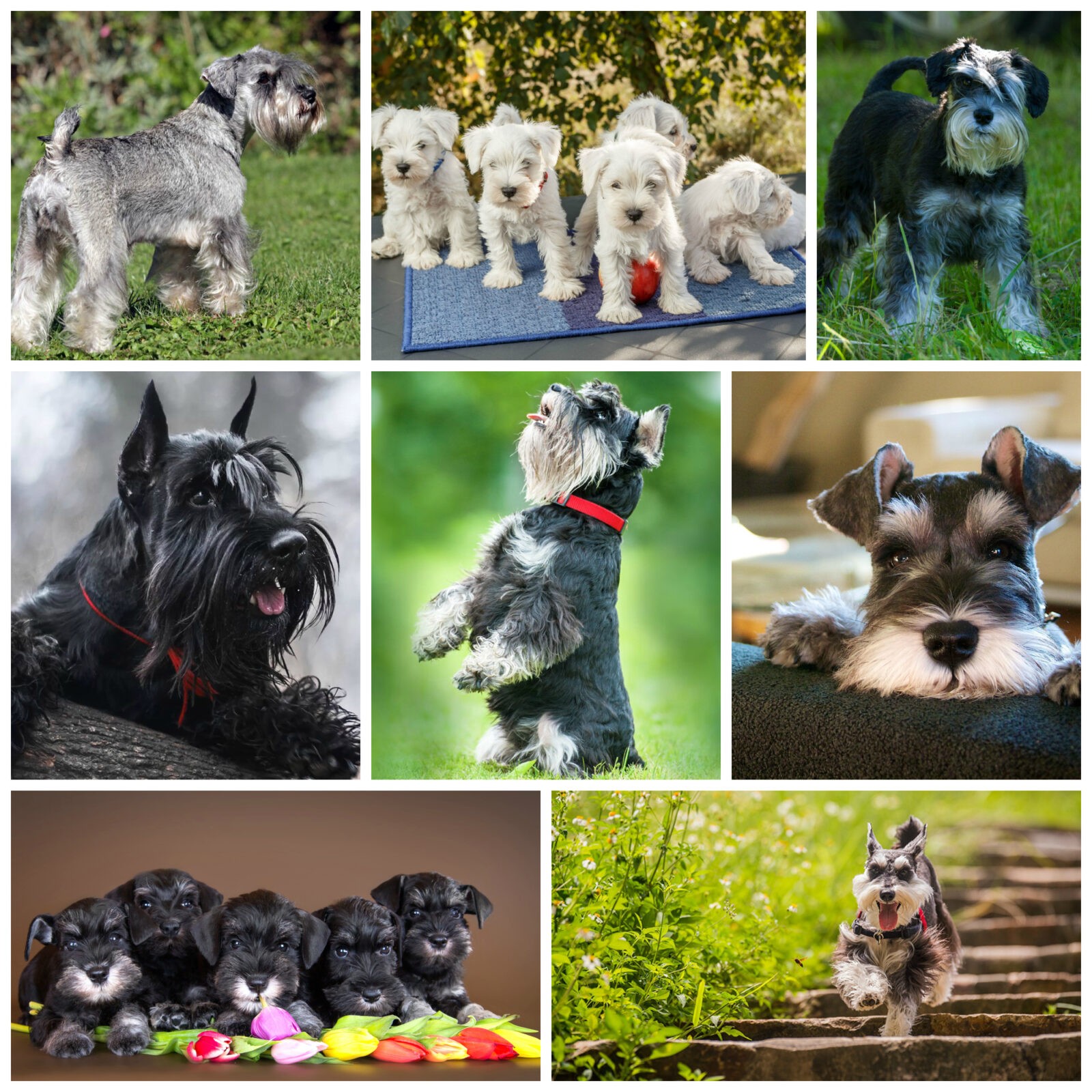
Brief description of the breed
Miniature Schnauzer (miniature schnauzer) - small dog with a "big" heart. She is in the TOP-20 of the most popular breeds in the USA, England and Germany, and is also one of the most popular breeds in many other countries of the world. The dog is incredibly devoted to the family, therefore it requires proper attention.
The appearance of the miniature schnauzer is somewhat bizarre: it has a long beard and thick eyebrows. It is also distinguished by mischief and activity. Often this breed is considered a smaller copy of the Giant Schnauzer, but still it is not, because the miniature schnauzer is an independent, unique breed in its own way, which has long taken its place among thousands of dog breeders around the world.
These dogs love to be the center of attention. They get along well with children and enjoy spending time with them. Despite their small size, miniature schnauzers are quite bold, so they often come into conflict with more large relativeswhich often leads to disastrous consequences. That is why while walking on the street you should keep your pet on a leash. Otherwise, you risk that your pet will start a chase or start a fight.
The size of the dog makes it an excellent city pet, but do not forget about the activity of the animal. This obliges the owner to provide his pet with daily exercise. Like all terriers, the miniature schnauzer needs to move a lot.
Animals of this breed adapt well to almost any conditions and any climate, so they can suit anyone: both a farmer and a city dweller. The main thing is enough attention.
Miniature Schnauzer very often comes to the defense of his master and family members. These dogs can be quite suspicious of strangers, often seeing them as a potential threat. That's why the miniature schnauzer will be able to warn you of danger, but you should not entrust him with the duties of a watchman.
The Miniature Schnauzer is very intelligent and easy to train. The dog is active and cheerful, with her you will never be bored. With all its positive qualities, the miniature schnauzer often shows stubbornness. As a manifestation of protest or disagreement with the owner, the pet may ignore him, not respond to commands, or even turn into a sleeper.
Don't let your dog do anything that's forbidden. Allowing the pet to do this once, he will repeat such actions constantly. Your perseverance is the key to a good miniature schnauzer upbringing!
Be prepared for the dog to dig holes in the yard. Another surprise that a miniature schnauzer can bring - decapitated rodents on the threshold of the house! The fact is that these dogs love to catch small rodents, while they do not really like to eat them.
Previously, most miniature schnauzer owners resorted to ear cropping for cosmetic purposes. Today, more and more dog breeders are inclined to believe that such a surgical intervention is inappropriate. Unlike tail docking, which is done to prevent future tail injury, ear docking is considered unreasonable. Despite this, today it is still quite common to meet miniature schnauzers with cropped ears. This, as they say, is a personal matter for everyone.
Describing the miniature schnauzer in a few words, the following can be said about him: he is an energetic, intelligent, cheerful, affectionate dog.
basic information
| Breed name: | miniature schnauzer |
| Country of origin: | Germany |
| The time of the birth of the breed: | 1888 |
| Type of: | pinscher and schnauzer |
| The weight: | 4 - 8 kg |
| Height (height at the withers): | 30 - 35 cm |
| Life Expectancy: | 12 - 14 years old |
|
ICF classification:
|
Group 2, Section 1, Room 183 |
| Puppies price: | 320 – 550 $ |
| Most popular nicknames: | List of nicknames for Miniature Schnauzer |
Evaluation of the characteristics of the miniature schnauzer breed
| Adaptability
(a definition meaning how easily a dog can adapt to changes in life) |
🐶🐶🐶🐶🐶 |
| Shedding level
(Level and frequency of hair loss in the animal) |
🐶 |
| Tenderness level
(The level and amount of tenderness and affection that the dog gives in return for attention to itself) |
🐶🐶🐶🐶🐶 |
| Exercise needs
(Dog's daytime activity level) |
🐶🐶🐶 |
| Social need
(The required number of contacts of the dog with other animals, as well as people) |
🐶🐶🐶🐶 |
| Apartment content
(A factor that determines the level of noise and other inconveniences that a dog can deliver to owners in relation to the size of the apartment to the size of the dog) |
🐶🐶🐶 |
| Grooming
(The number of bathing, brushing, and the number of professional grooming sessions required for the dog) |
🐶🐶🐶🐶 |
| Friendliness in an unfamiliar environment
(Features of the behavior of a dog in a society with strangers or in an unfamiliar environment) |
🐶🐶🐶 |
| Tendency to bark
(Tendency to bark and its frequency and volume) |
🐶🐶🐶🐶🐶 |
| Health issues
(Potential health status of the dog) |
🐶🐶🐶 |
| Territoriality
(The dog's tendency to protect his home, yard, or even his owner's car) |
🐶🐶🐶🐶 |
| Friendliness to cats
(The tendency towards tolerance for cats and decreased manifestation of hunting instincts) |
🐶🐶🐶 |
| Intelligence
(The ability of the dog to think and solve emerging difficulties (not to be confused with learning!) |
🐶🐶🐶🐶🐶 |
| Education and training
(The level of difficulty in training the dog to perform certain actions) |
🐶🐶🐶🐶🐶 |
| Friendliness to children
(A factor that determines how friendly a dog is to children, whether he likes to play with them and tolerate some childish pranks) |
🐶🐶🐶 |
| Game activity
(The concept is determined by its very name, and, as a rule, is found in almost all dogs) |
🐶🐶🐶 |
| Observation
(The ability of a dog to detect the presence of a stranger on its territory) |
🐶🐶🐶🐶🐶 |
| Friendliness to other dogs
(The tendency of the dog to find common language with his other relatives) |
🐶🐶🐶 |
Photo of Zwergschnauzer:
The history of the origin of the miniature schnauzer
The Miniature Schnauzer was originally bred as a farm guard dog capable of hunting rats. It was bred in the 19th century in Germany by crossing an ordinary schnauzer with small dog breedssuch as Pinscher, Poodle or Spitz. In Germany, the dog is known as a "Zwerg".
In fairness, we say that there is no reliable information about the breeding of this breed, there are no official documents about this. The process of breeding this breed was negatively affected by the First and Second World Wars. During this period, some breeds of dogs almost disappeared.
Today, miniature schnauzers of black and silver color are in fashion. But a few years ago, dogs of different sizes and colors were popular: red, black and tan, yellow. It is noteworthy that the American Kennel Club classifies this breed as a terrier and classifies it as a working group dog.
The nature of the miniature schnauzer
Maintenance and care
In order for the Miniature Schnauzer to remain handsome, it must be well looked after. The coat should be brushed about two to three times a week. But you will have to cut the hair on average once every two months. Most miniature schnauzer owners prefer to go to professional groomers. The fact is that it is not easy to carry out the correct haircut in dogs of this breed. In addition, if you are planning your dog's participation in an exhibition, then you simply cannot do without a master.
Despite the fact that the breed does not shed, the hair falls out of the undercoat, so regular combing is indispensable. Wash your dog's beard thoroughly after each feeding. It should be free of food debris and other contaminants.
Check your miniature schnauzer's ears regularly for signs of dirt, irritation, and infection. You need to treat the ears with a special swab and a solution prescribed by a veterinarian. Never use a cotton swab for this!
Weekly brushing will prevent tartar, gum disease, and bad breath. The nails are trimmed as needed, usually once a month.
Training and education of the miniature schnauzer
Miniature Schnauzers are easy to train dog breeds because they are very intelligent and ready to use their mind for its intended purpose. These dogs are indeed stubborn, but not to such an extent that it becomes an obstacle in the process of training. Schnauzers do not like to be commanded, so do not show excessive assertiveness, much less aggression.
Teaching should take place in a calm but persistent manner. Training must begin at an early age. Lessons should not be long. It is good if the success of the pet will be rewarded with treats. Do not forget that it is necessary to select a variety of exercises so that they do not bother the pet.
Once your dog has mastered the basic commands and rules of behavior in everyday life, you can move on to more complex commands, including preparing for various competitions. Don't forget that the rules of learning remain the same - moderate perseverance and systematic.
Health and disease of the miniature schnauzer
Some interesting facts
- miniature schnauzer - dogwho cannot imagine her life without a person. Do not leave your pet alone for long periods of time.
- The Miniature Schnauzer is full of life and energy. He is smart, mischievous and very devoted to man.
- The miniature schnauzer is not prone to heavy molting, and in its content it is not whimsical.
- Miniature Schnauzer learns quickly, he achieves special success in various competitions and competitions.
- Dogs This breed is quite noisy. They will stand guard over the house and react with barks to any noises that will cause the animal to suspect danger.
- Miniature Schnauzer gets along well with children and animals. In this case, you should not leave a dog with small animals unattended.
- Keep your pet on a leash while walking. These dogs are prone to chasing other animals outside.
- Boredom for a miniature schnauzer is a real test. This is a very active dog, which means that she needs active games and human society. Lack of active exercise can lead to aggression and the animal falling into a stressful state.
- To be the owner of a healthy and strong puppy, do not purchase it from random breeders. Trust only proven, reliable dog breeders.
Nurseries and breeders
We borrowed material from the wonderful site of our partners DOGCATFAN.COM about cats and dogs, the author dogcatfan

